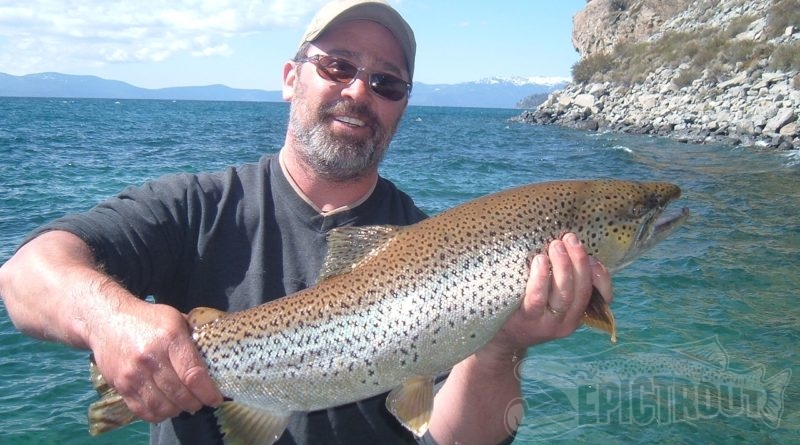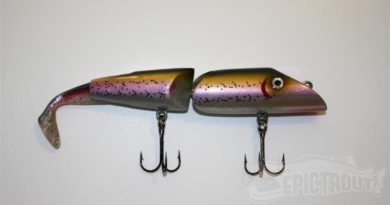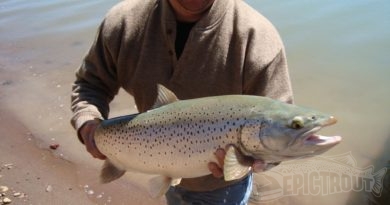Trolling Minnow Plugs For Trout
Some people collect cars. Some collect coins. Some guys even collect antique fishing lures that are too valuable to use, and must be kept in a glass front, velvet lined case. As a natural pack-rat, I collect many things. As a fisherman, however, I collect as a serious hobby only one thing, minnow plugs. Sure I tie my own flies, and have a dozen rods and reels, but I’m talking serious!
My interest is practical, though. I use my plugs constantly, to troll California lakes for trout. You won’t see a stamp collector licking his precious little stickers for their intended purpose. Of course, rare stamps are kept for their monetary value; they must be preserved, unused, in pristine condition. I add new battle scars to my lures every week, and at five to fifteen dollars each, I believe if I sold them off, I could finance a good portion of my children’s education at a state college.
Rapalas occupy the most spaces in the clear, compartmentalized plastic boxes that stuff my tackle-bag, and with good reason. They truly are the king of minnow plugs. Their reputation stems from decades of angler experience, in which they have been proven productive around the world, for every predator species from bluegill to bluefin tuna. Success spawns imitation, though; I just received my new Bass Pro Shops spring catalog, and it seems that minnow plugs are enjoying something of a renaissance. I have never seen more pages, nor more manufacturers of slender, plastic lipped, fish-imitating lures.

But the centerfold, of course, with a several page spread, is the Rapala section. From the original balsa wood floating minnows, the Normark Corporation has expanded their line extensively in recent years, to keep pace with the plethora of competitors. I use both the oldest, original Rapala designs and the latest innovations in my trout trolling- the key to presenting these “little wooden fishes” effectively lies in understanding each model’s properties when pulled through the water behind a moving boat. Let’s look at some trolling applications for basic plug types, applicable not only for trout, but also walleyes, stripers and a host of other minnow-oriented gamefish
.
Floating Plugs: The floating Rapala is the classic example of this, the basic stickbait. A slim plug of high-riding balsa, it is made to dive beneath the surface and wiggle when retrieved due to a plastic lip at the underside of the head, angled to dig into the water and provide a resistance to forward movement that simultaneously submerges the lure and causes it to shimmy from side to side. I started casting and retrieving minnow plugs for bass when I was a boy, and have long been familiar with their properties when twitched on the surface for smallmouth or pulled along weedlines for largemouth and pickerel. Only in the last few years, though, have I figured out what a deadly trolling bait a well-tuned minnow plug can be.
Tuning: This is achieved by bending the metal loop to which your line attaches at the lure’s nose. Needle nose or surgical pliers are helpful here. A quality minnow plug usually comes out of the box properly tuned, but like your car’s front-end alignment, one good impact with a rock can put it out of whack. An out-of-tune plug on a long line will track across other trolled lines, tangling them, and may even flip over repeatedly as it swims, causing tremendous line twist. I check a plug’s action at boatside at the start of every troll. A correctly tuned plug should dig straight down in the water and move forward in line with the boat. If it digs or tracks to the left, bend the nose-loop slightly to the right. If it tracks right, bend left. Properly balanced, even small plugs are capable of running straight and digging down to the limit of their depth range indefinitely when trolled.
Some plugs, such as the Rebel Minnow, have an additional split ring attached to the nose-loop, allowing for a freer wiggling action. These may still require tuning, though, by bending the loop in the same fashion. The split ring eliminates the need for tying a loop-knot, which brings me to the subject of knots for minnow plugs. Rapala recommends the “Rapala Knot”, a loop knot, for best lure-action. I don’t trust this knot, as it has a simple overhead knot in its construction, which like a wind-knot in a fly-fishing leader, causes the line to cut into itself, significantly reducing line strength. I forgo the loop knot entirely, tying most of my minnow plugs with either a Palomar or Trilene knot for maximum strength, and have found that action is not compromised except when trolling the largest, heaviest plugs at less than top speed. In this case, I again ignore the recommendations from Rapala and attach a simple metal snap (not a swivel) in place of the loop-knot, while still allowing me to tie my favorite high-strength knots.
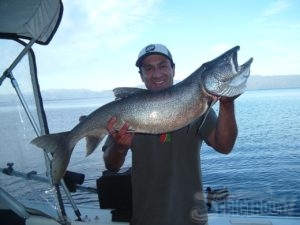
Speed: Once you have made sure your minnow plug will track straight while trolling, you need to decide how fast or slow to pull it. Assuming a similar, slim minnow profile, action at different speeds is largely a function of lure size and weight. As a rule, the longer the plug, the higher the trolling speed necessary to bring out its best wobbling action. The smallest floating Rapalas work well at slow speeds, and can be trolled behind attractors, such as flashers, that also require low trolling speed. The larger sizes, though, need to be moved at a good clip, several miles per hour, for maximum action. This is too fast to be coupled with attractor blades, which is just fine, because large minnow plugs work quite well alone, trolled at high speeds for large trout. They appear as a worthy meal to large brown trout, rainbows and mackinaw, and the high rate of speed helps trigger an attack response from wary, wild fish that would have time to inspect and reject a slowly moving lure. When in doubt, put your lure into the water at boatside on ten feet or so of line, observing its action as you start moving at your motor’s slowest possible speed. Pre-dawn will often find me shining my headlamp into the water to inspect my submerged, running lure in the dark. Experiment with different speeds, looking closely at the plug’s movement to determine the best speed for that particular plug. Let your chosen lure dictate trolling speed by determining what rate imparts the maximum action. You may also find that a lure which appeared to be tracking true at lower speeds will begin to veer off course as you pick up the pace. The faster you troll, the more critical lure tuning becomes. For medium to large size minnow plugs, try trolling at 2.5 to 3.5 MPH, starting at the lower end of this range when surface water temperature is near 40 degrees, and the higher end when the temp is 50 degrees or above.
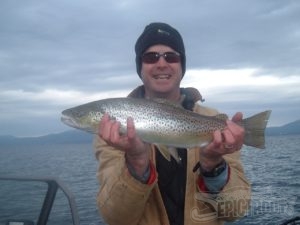
Depth: I must admit, I’m spoiled, since I live three blocks from Lake Tahoe. Okay, it’s a cheap rental, but I can see a small patch of the lake over the roof of Nell’s Hardware through my second-floor bathroom window, telling me if the water is calm enough to go fishing in my canoe. I’m in California’s limited snowbelt, and ambient water and air temperatures at this altitude keep trout near the surface much of the year. Of course, minnow plugs work at any depth, since they excel with such deepwater applications as downriggers and leadcore line. Trolled shallow without additional weight, though, each size and type of lure has its own maximum running depth. Knowing where your plug is in relation to the bottom is critical to an effective presentation. At times, fish will rise up from great depths to hit a plug running near the surface, but the majority will seek their prey close to bottom structure. Some professional walleye anglers consult a crankbait depth chart book for accuracy, but with a basic sonar unit, 3,000 hours or so of trolling, and a willingness to lose expensive fishing lures in the rocks, I’ve managed to create my own mental “cheat sheet” that allows me to troll plugs with accuracy.
Here’s a peek, running depths of lures topline trolled on 100 yards of light mono, six to eight pound test Berkeley Trilene. These specifications allow each lure to run at near maximum depth. A significantly shorter line will cause your lure to run shallower, as will use of thicker diameter line. These are some of my favorite large, shallow-trolling plugs for big trout on Lake Tahoe.
Plug Type Depth
# 13 Rapala Floating- 10 – 12 feet
# 11 Rapala Jointed – 10 – 12 feet
#13 Rapala Jointed- 13 -16 feet
#14 Rapala Husky Jerk- 13 -16 feet
#11 Rapala Countdown- 17 – 20 feet
J-55 Deep Diving Rebel- 25 – 28 feet
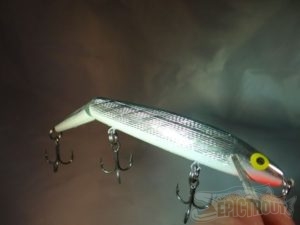
As you can see, plugs with different running depths can be used to fish different parts of the water column. You can run right over shallow rocks with smaller floating plugs, then fish a thirty foot deep ledge with deep divers. I’ve talked so far mainly about straight, floating plugs, but the variations are endless. Let’s take a closer look at some of the models listed in my depth chart:
Jointed Plugs: These are normally floating plugs as well, though there are sinking models available. Rapala Jointed and Rebel Broken-Back Minnows are two effective versions for trolling. The lure is essentially the basic floating version, separated into front and rear halves which are connected by freely moving, interlocked metal rings. The result is a lure that tracks and trolls in the same manner as a straight plug, but with a wider, wilder wiggle as the two halves swing back and forth. A great alternative when standard plugs are not producing; I’ve been having success all season with a #11, clown pattern Rapala Jointed.
Husky Jerk: No, this is not what you call the overweight loudmouth at a party. One of the more “high-tech” plugs offered by Rapala, The Jerk breaks the company’s long-standing tradition of balsa-wood lures with a molded plastic body. This model neither floats nor sinks, its neutral buoyancy causing it to suspend when stopped at whatever depth its lip has pulled it to during a retrieve. Trolled, it has characteristics similar to floating Rapalas, with some key differences.
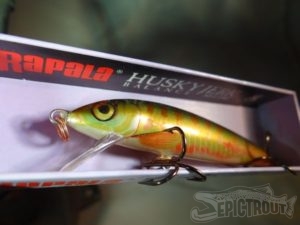
The additional weight required to create a suspending lure causes it to run slightly deeper than a floater of the same size, and it has a slightly wider wobble as well. It also has a bit more flash and shine in its finish than most painted, balsa plugs, and contains metal balls in an internal chamber that give it a loud, fish attracting rattle. This lure stays tuned longer and can take more abuse than a balsa Rapala, and the “bells-and-whistles” really do serve to give an edge when fish are not striking a standard minnow plug. In the silver, rainbow trout, and Tennessee shad finishes, this lure has accounted for many fine catches on trips I’ve taken to Tahoe, Caples and Fallen Leaf lakes.
Countdown: Yes, you certainly can “count-down” this sinking lure, casting it out and letting it drop, at one foot per second, then retrieving it at a desired depth. It is also a deadly trolling lure, with the larger sizes accounting for many trophy Tahoe trout over the years. This weighted plug needs higher trolling speeds in a given size than the same size floater to achieve optimum action, and unlike with floating plugs, the trolling line must be let out under tension, so the Countdown does not sink to the bottom and hang up. Its ability to run deeper, and to drop rather than rise during turns, gives it a unique action, producing fish that would not move upward to strike a floating plug. Try a # 9 or 11 rainbow, black and silver, or vampire pattern along steep shorelines or offshore drops.
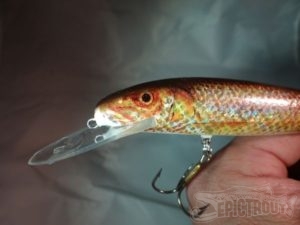
Deep Divers: Most are floating plugs, but whatever their weight, what differentiates this type of “crankbait” is its oversize plastic lip, which digs it deeper per weight and body size than a plug with a smaller lip. A major advantage of large-lipped, floating divers is their split personality. They float at rest, yet dive deep on the retrieve, deeper still on a long-line troll. Letting out a trolling line is therefore as easy as setting your reel on free-spool, and if the lure runs too close to the rocks and starts to tap bottom while trolling, it can be allowed to rise shallower by slowing or stopping your boat, avoiding hangups. My favorite big-fish version is the saltwater size, deep-diving Rebel Broken Back in the blue and silver finish. Rapala makes a Down Deep Husky Jerk that performs similarly, and the classic Rapala Shad Rap is a good, shorter-bodied alternative.
At first glance, minnow plugs may all appear the same, with limited trout fishing applications. Don’t believe it! I have not even mentioned my experience casting these lures in rivers, nor the unique characteristics of the Bomber Long-A, Rebel Crawfish, or the Storm plugs, all of which have found a place in my tackle bag in recent years. If you’ve never trolled plugs for trout, try a Rapala, and if you are a loyal Rapala user, try some of the new products available. Once you work out the kinks, you’ll increase your catch, and before the checkout clerk can say “Twelve dollars and thirty-five cents please”, you’ll look in your tackle box, and realize you’re a collector too.

